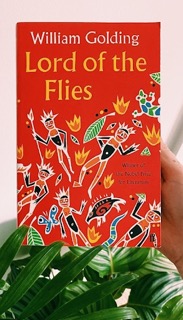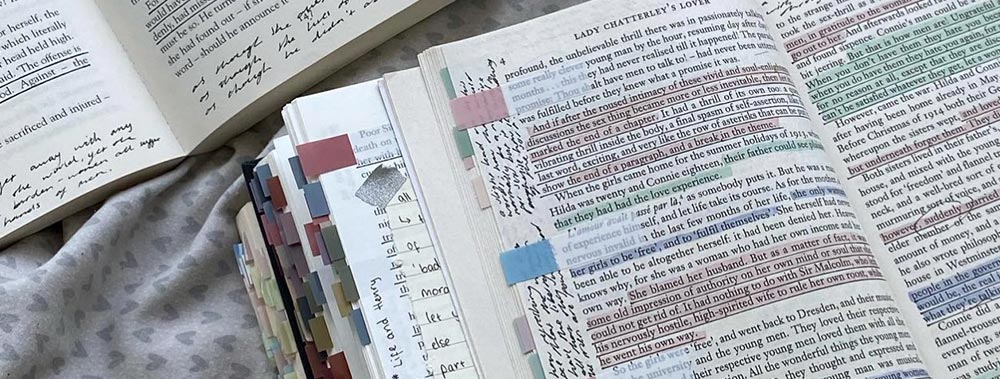Lord of the Flies Chapter 6: Summary, Plot, Characters, Literary Analysis & More
This post offers a complete “Lord of the Flies” Chapter 6 summary. See also our full “Lord of the Flies” summary.
This chapter within “Lord of the Flies” by William Golding, first published in 1954, delves into the challenges faced by the boys, the dynamics between Ralph and Jack, and the evolving power struggle on the island. This chapter is pivotal in examining themes like fear, leadership, and the descent into savagery.
This novel is one of Golding’s most acclaimed works, exploring the primal instincts and dark facets of human nature when a group of boys stranded on a deserted island struggle for survival.

"Lord of the Flies" is one of Golding's most acclaimed works, exploring the primal instincts and dark facets of human nature.
Table of Contents
Summary The Plot Characters Key Themes Genres Language used Literary devices Summing upThe Plot
In Chapter 6 of “Lord of the Flies,” the boys’ precarious situation intensifies.
Ralph calls a meeting to address the importance of maintaining the signal fire, symbolizing the hope of rescue, but the other boys are more interested in hunting.
Jack leads a group to Castle Rock, further distancing them from the adult world’s responsibilities. As the boys sleep, the fire burns low, and the opportunity for rescue dwindles.
This chapter highlights the growing divide between Ralph’s focus on rescue and Jack’s obsession with hunting, setting the stage for a power struggle and the unraveling of their civilized behavior.
Characters
Chapter 6 of “Lord of the Flies” introduces a variety of characters, each contributing to the evolving dynamics on the island. These characters play crucial roles in illustrating the conflict between order and chaos.
Ralph
Ralph calls for responsibility, representing the adult world’s values and the importance of the signal fire. He strives to maintain a sense of order among the boys.
Jack
Jack leads a group of boys to Castle Rock, symbolizing the allure of savagery and the abandonment of societal norms. His leadership becomes a catalyst for the boys’ descent into primal behavior.
All the Boys
Collectively refers to the group of boys who are stranded on a deserted island.
Their actions and decisions as a group play a significant role in the chapter, as they grapple with the choice between maintaining the signal fire and succumbing to the primal instincts of hunting,
Key Themes
In “Lord of the Flies,” William Golding explores several overarching themes that delve into the human condition and society’s fragility.
Chapter 6 delves deeper into these themes, shedding light on the evolving dynamics among the stranded boys.
Civilization vs. Savagery
Chapter 6 showcases the growing tension between Ralph’s commitment to civilization and order, symbolized by the signal fire, and Jack’s inclination towards savage impulses, seen in his leadership at Castle Rock.
Fear and Descent into Darkness
The boys’ fear of the mysterious “beast” intensifies in this chapter, revealing how fear can drive individuals towards irrational and destructive behavior, eroding their sense of morality and humanity.
Leadership and Power
The struggle for leadership between Ralph and Jack becomes more pronounced, highlighting how power dynamics and the desire for control can lead to conflicts and divisions within a group, ultimately affecting their survival on the island.
Genres in Lord of the Flies Chapter 6
“Lord of the Flies” is a novel that defies easy categorization, blending multiple genres to create a compelling narrative. Chapter 6 further exemplifies this genre’s versatility, adding depth to the story.
Survival Fiction
Chapter 6 delves into the survival genre as the boys grapple with the challenges of maintaining a signal fire and hunting for sustenance, reflecting the harsh realities of their isolated existence and their efforts to adapt to the adult world’s demands.
Psychological Thriller
The chapter takes on elements of a psychological thriller as the boys’ fear of the “beast” lurking on the island intensifies, leading to heightened tension and a growing sense of dread, evoking fear not only in the characters but also in the reader.
Adventure Fiction
Chapter 6 retains the adventurous spirit of the novel, with the boys exploring Castle Rock and embarking on a quest for the “beast.”
The sense of adventure is coupled with a darker undertone as they confront the unknown, blurring the lines between adventure and danger.
Language used in Lord of the Flies Chapter 6
In this chapter, Golding employs a vivid and descriptive writing style that masterfully captures the complexities of the boys’ struggles on the island.
Through his language, Golding creates a palpable atmosphere of tension and uncertainty, skillfully conveying the clash between the innocence of childhood and the harsh realities of the adult world.
The author’s prose deftly navigates the evolving emotions of fear, desperation, and the allure of savagery, immersing the reader in the unsettling and thought-provoking narrative.
Literary devices in Lord of the Flies Chapter 6
Chapter 6 of “Lord of the Flies” employs a variety of literary devices to enhance its narrative impact. Building on elements from the previous chapter, Golding continues to utilize symbolism to explore the themes of power and the loss of innocence.
The air battle and the mention of the fallen pilot serve as poignant symbols representing the adult world’s disruption and decay.
Additionally, the use of the phrase “even Ralph” underscores the unsettling transformation of characters, while the image of the dead pilot continues to foreshadow the boys’ descent into darkness.
Similes
In Chapter 6 of “Lord of the Flies,” similes are sparingly used to emphasize certain situations. For example, when the boys have “fallen asleep like stones,” it conveys the depth of their exhaustion, likening them to inanimate objects.
This simile engages the reader by vividly illustrating their physical and emotional weariness.
Analogies
In Chapter 6 of “Lord of the Flies,” an analogy is presented through the “rock formation.” This natural feature on the island serves as an analogy for the boys’ evolving social structure.
Just as the rocks stand firm amidst the chaos of the island, the formation symbolizes the persistent presence of conflict and division among the boys.
Imagery
The author employs vivid imagery throughout the chapter, describing the mountain and the boys’ actions in detail.
This creates sensory experiences for the reader, enabling them to visualize the rugged terrain, the tension in the air, and the mounting fear and excitement that the boys experience.
Symbolism
Symbolism plays a significant role in Chapter 6, with the mountain symbolizing the boys’ aspirations, the war within themselves, and the hunt for the truth about the “beast.”
Additionally, the severed pig’s head, known as the “Lord of the Flies,” serves as a symbol of the inherent evil within humanity, connecting to the larger theme of the darkness lurking in human nature.
Personification
Personification in Chapter 6 of “Lord of the Flies” adds depth to both the characters and the setting. The most notable instance is the personification of the severed pig’s head, referred to as the “Lord of the Flies.”
It is given human-like qualities, engaging in dialogue with Simon and representing the evil and darkness residing within the boys themselves. This personification intensifies the psychological and moral aspects of the story.
Irony
Irony, particularly dramatic irony, is prevalent in Chapter 6. The boys mistake the dead parachutist for the “beast,” unaware of the reality.
This dramatic irony heightens suspense and contributes to the overall sense of foreboding, as the readers possess knowledge that the characters lack, creating a powerful narrative tension.
Juxtaposition
In Chapter 6 of “Lord of the Flies,” juxtaposition is employed to highlight contrasts between the characters.
The contrast between Ralph’s commitment to maintaining the signal fire, symbolizing civilization, and Jack’s pursuit of savagery at Castle Rock creates thought-provoking scenarios that underscore the growing divide among the boys.
Paradox
Paradoxical situations arise when the boys, despite their fear of the “beast,” engage in a frenzied hunt for it.
This paradox reflects the irrationality of their actions, where fear and curiosity coexist, illustrating the complexity of human behavior.
Allusion
The chapter contains an allusion to the concept of adults and civilization, contrasting the boys’ behavior with what would be expected from adults.
This allusion serves to emphasize the loss of innocence and societal norms in their descent into chaos. Additionally, the mention of the “flies study guide” alludes to educational structures, highlighting the breakdown of order and learning in the absence of adults.
Allegory
Chapter 6 of “Lord of the Flies” contains allegorical elements that represent broader themes. The “beast,” which the boys fear, is an allegorical representation of the darkness within human nature.
It symbolizes the innate capacity for evil that can emerge when societal norms and order break down, serving as a microcosm of the broader human condition.
Onomatopoeia
While Chapter 6 does not prominently feature onomatopoeic words, the author’s skillful use of descriptive language immerses the reader in the auditory dimensions of the narrative, allowing them to hear the rustling leaves, the distant waves, and the boys’ voices as they navigate the island’s challenges.
Repetition
Repetition is subtly used in Chapter 6 of “Lord of the Flies” to underscore key themes and emotions. The repeated mention of the “beast” intensifies the boys’ fear and paranoia, emphasizing the primal forces that threaten their fragile civilization.
This repetition reinforces the theme of the innate darkness within human nature and heightens the emotional impact of their ordeal.
The Use of Dialogue
Dialogue is a crucial tool in conveying character traits and themes. Ralph’s dialogue emphasizes his commitment to maintaining order and the signal fire, contrasting with Jack’s increasingly authoritarian tone, highlighting the themes of leadership and power struggles among the boys.
Parallelism
In Chapter 6 of “Lord of the Flies,” parallelism can be observed in the repeated pattern of the boys’ actions. Their repeated failure to maintain the signal fire, instead opting to engage in hunting, mirrors a consistent pattern.
This parallelism contributes to the chapter’s structure by highlighting the growing divide between Ralph’s focus on rescue and Jack’s obsession with hunting.
It reinforces the message that the boys are increasingly succumbing to their primal instincts, jeopardizing their chances of being rescued, and symbolizing the broader theme of the conflict between civilization and savagery.
Rhetorical Devices
In Chapter 6 of “Lord of the Flies,” rhetorical devices, particularly rhetorical questions, are employed to persuade and provoke thought.
For example, when Ralph asks, “What can we do?” in the context of maintaining the signal fire, it serves as a rhetorical question that highlights the urgency of their situation and implies that the boys should prioritize rescue over hunting.
This persuasive use of rhetoric underscores the importance of their predicament and attempts to sway the boys’ decisions toward a more responsible course of action.
Lord of the Flies Chapter 6: FAQs
Welcome to the FAQ section for “Lord of the Flies” Chapter 6.
Here, we address common questions and provide insights into the key elements, themes, and literary devices found in this pivotal chapter of William Golding’s timeless novel.
What happened with the other boys in Chapter 6 of the Lord of the Flies?
In Chapter 6 of “Lord of the Flies,” the other boys become increasingly divided between Ralph’s focus on maintaining the signal fire and Jack’s obsession with hunting. The tension escalates as the boys’ loyalties shift, marking a turning point in their behavior on the island.
What did Ralph do with signal fire in Chapter 6 of Lord of the Flies?
Ralph attempted to maintain the signal fire in Chapter 6, emphasizing its importance as a potential rescue signal. However, as the chapter progresses, the boys’ attention and commitment to the fire wane, leading to dire consequences.
What does Chapter 6 LOTF symbolize?
Chapter 6 of “Lord of the Flies” symbolizes the growing conflict between civilization and savagery on the island. It serves as a microcosm of the broader human condition, where the boys’ descent into primal behavior underscores the fragility of societal norms and the darkness within human nature.
What does Simon do in Chapter 6?
In Chapter 6, Simon goes off on his own into the forest. He has a mystical encounter with the severed pig’s head, known as the “Lord of the Flies,” which symbolizes the evil within humanity. This unsettling encounter with the head contributes to Simon’s growing understanding of the true nature of the “beast.”
Summing up: Lord of the Flies Chapter 6: Summary, Plot & More
As you can see from this “Lord of the Flies” Chapter 6 summary, in this chapter we witness a pivotal juncture in the unfolding narrative, where the boys’ descent into savagery and their internal power struggles intensify.
The symbolism of the “beast,” the stark contrasts between Ralph and Jack’s leadership, and the constant battle between civilization and primal instincts come to the forefront.
Through the author’s masterful use of literary devices and the exploration of profound themes, this chapter serves as a microcosm of the broader human condition.
“Lord of the Flies” as a whole, and Chapter 6 in particular, continues to resonate with readers due to its timeless exploration of the darker aspects of human nature, the fragility of civilization, and the tension between order and chaos.
Its impact lies in its ability to provoke deep introspection about the human condition, making it a compelling and enduring work that continues to captivate and challenge readers across generations.
Other Notable Works by William Golding
If you are interested in “Lord of the Flies,”, you may be interested in other works by William Golding including:
- “The Inheritors” (1955): This novel explores the clash between Neanderthals and Homo sapiens, delving into themes of evolution and the inherent violence in humanity.
- “Pincher Martin” (1956): A psychological survival story about a shipwrecked naval officer, this novel delves into the isolation of the human mind and the struggle for survival.
- “The Spire” (1964): A novel set in medieval England, it tells the story of the construction of a massive spire on a cathedral, exploring themes of ambition, faith, and obsession.
- “The Pyramid” (1967): This novel is a semi-autobiographical work that delves into the author’s experiences during World War II, offering a unique perspective on the horrors of war.
- “Rites of Passage” (1980): The first book in the “To the Ends of the Earth” trilogy, it explores the experiences of passengers on a ship bound for Australia in the 19th century, touching on themes of class, morality, and the voyage of self-discovery.
These works by William Golding showcase his versatility as a writer, exploring various themes and genres beyond the confines of “Lord of the Flies.”







